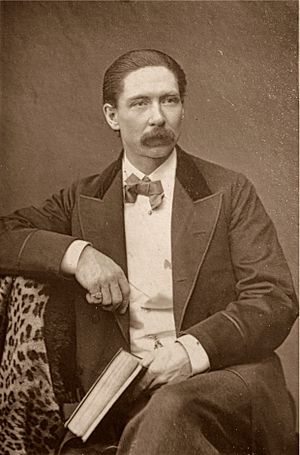John Nevil Maskelyne facts for kids
Quick facts for kids
John Nevil Maskelyne
|
|
|---|---|
 |
|
| Born | 22 December 1839 Cheltenham, Gloucestershire, England
|
| Died | 18 May 1917 (aged 77) Marylebone, London, England
|
| Occupation | Magician, escapologist, inventor, and paranormal investigator |
| Spouse(s) | Elizabeth Taylor (1840–1911) |
| Children | Nevil Maskelyne |
| Parent(s) |
|
John Nevil Maskelyne (born December 22, 1839 – died May 18, 1917) was a famous English magician. He was also a clever inventor! He created the first pay toilet and other cool devices from the Victorian era. Maskelyne worked with other magicians like George Alfred Cooke and David Devant. Many of the magic tricks he invented are still performed by magicians today. He also wrote a famous book called Sharps and Flats, which showed how people cheated at games. In 1914, he started a group called the Occult Committee. This group's job was to check if people really had supernatural powers or if they were just tricking others.
Contents
Early Life of a Magician
John Nevil Maskelyne was born in Cheltenham, England, on December 22, 1839. His father, also named John Nevil Maskelyne, was a saddler. His mother was Harriet Brunsdon. Young Maskelyne trained to become a watchmaker.
Maskelyne's Magic Career
Maskelyne became very interested in magic after seeing a show by the Davenport brothers. These American performers claimed to have supernatural powers. They used a "spirit cabinet" illusion. Maskelyne quickly figured out how their trick worked. He told the audience he could do the same act without any real magic.
Exposing the Davenport Brothers
With his friend George Alfred Cooke, a cabinet maker, Maskelyne built his own large cabinet. In June 1865, they showed the public in Cheltenham how the Davenport Brothers' tricks were done. Their show was a big hit! They even added funny illusions, like changing into a woman and a gorilla. People loved how clever they were at showing the deception.
After their local success, Maskelyne and Cooke decided to become professional magicians. They started touring different towns. At first, it was tough to make enough money. But then, a theater agent named William Morton saw their show. He offered to help them with their tours.
Morton managed them for 20 years. He helped them become very famous across the country. They even had a long-running show at the Egyptian Hall in Piccadilly, London. This show lasted for an amazing 31 years, ending in 1905.
Inventing New Illusions
During his shows, Maskelyne often turned his magic tricks into short plays. His performances at the Egyptian Hall inspired the famous magician and filmmaker Georges Méliès. Méliès later used special effects and illusions in his own short films.
Maskelyne and Cooke invented many magic tricks that are still performed today. Maskelyne was especially good at figuring out how illusions worked. One of his most famous inventions was the levitation illusion. Many people mistakenly think another magician, Jean Eugène Robert-Houdin, invented it. But it was Maskelyne's creation.
After Cooke passed away in 1905, Maskelyne partnered with another magician, David Devant. Devant had joined Maskelyne's team earlier, in 1893.
Writing About Cheating
In 1894, Maskelyne wrote a very important book called Sharps and Flats: A Complete Revelation of the Secrets of Cheating at Games of Chance and Skill. This book became an instant success. It is still considered a classic book about gambling. It was the first time anyone had explained in detail how cardsharps (people who cheat at cards) did their tricks. The book is now available online for everyone to read.
A Skeptic of the Supernatural
Maskelyne became a magician because he wanted to show that the Davenport brothers' "supernatural" acts were just tricks. He and Cooke were always open about using clever tricks, not real magic. They called their show an "entertainment of pure trickery."
Maskelyne was a member of The Magic Circle. Like the famous magician Harry Houdini, he worked to show that there were no real supernatural powers. In 1914, he started the Occult Committee. This group's goal was to "investigate claims to supernatural power and to expose fraud." For example, they tried to prove that the famous Indian rope trick had never actually been performed.
Maskelyne also helped expose other mediums (people who claim to talk to spirits). In 1876, he was a witness in a fraud case against a medium named Henry Slade. Slade was found guilty of fraud.
Maskelyne also wrote about his doubts regarding Spiritualism and Theosophy. His ideas were included in a book called The Supernatural? (1891). This book explained how many supposed supernatural events could be understood using science and psychology.
Maskelyne's Inventions
Maskelyne was not just a magician; he was also a talented inventor.
Typewriter
With his son, John Nevil Maskelyne Jr., Maskelyne invented a special typewriter. This machine used an ink pad to ink the letters. It also typed proportionally, meaning some letters took up more space than others. This was a new idea for typewriters at the time.
Pay Toilet Lock
Maskelyne invented the coin-operated lock for public toilets in London. To open the door, you had to put in a penny coin. This is where the saying "to spend a penny" comes from, meaning to use the toilet.
Psycho Automaton
With John Algernon Clarke, Maskelyne invented a machine called the Psycho Automaton. This machine was said to be able to play the card game Whist. Psycho performed over 4,000 times at London's Egyptian Hall, amazing audiences.
Family Life
Maskelyne married Elizabeth Taylor in 1862. They had three children:
- Nevil Maskelyne (1863–1924)
- Minnie Jane Maskelyne (1866–1942)
- Edwin Archibald Maskelyne (1879–1920)
His son Nevil also became a magician. Nevil's son, Jasper Maskelyne, also became a magician. Jasper is famous for possibly creating large-scale tricks and camouflage used during the Second World War.
Maskelyne died from pneumonia in 1917.
See also
 In Spanish: John Nevil Maskelyne para niños
In Spanish: John Nevil Maskelyne para niños

